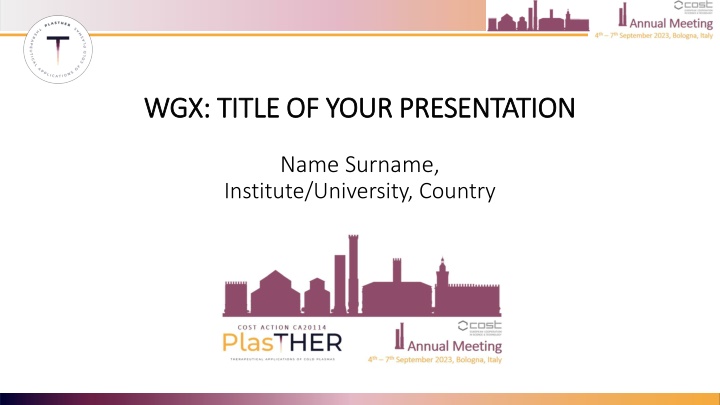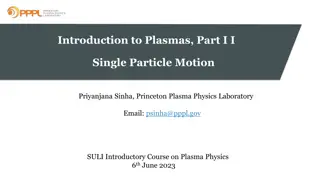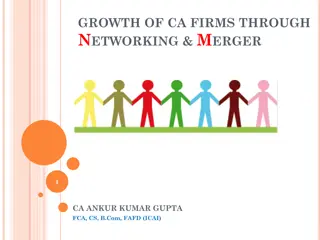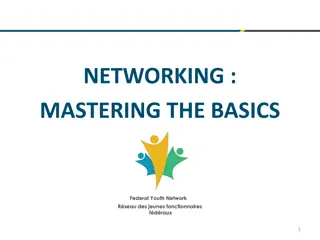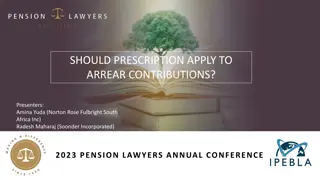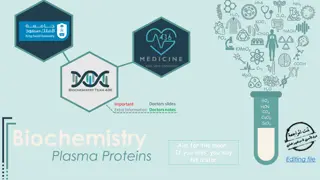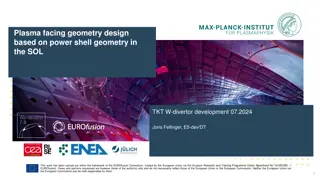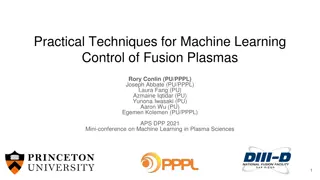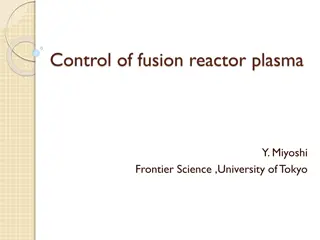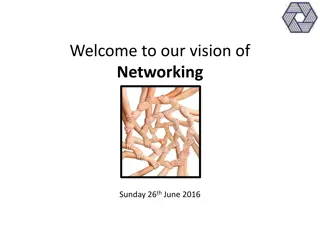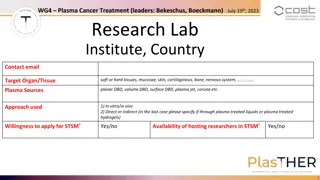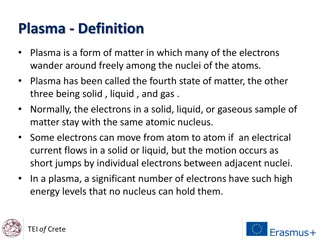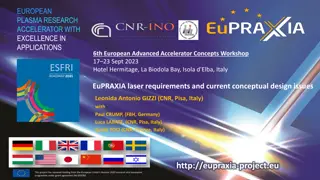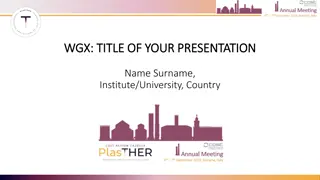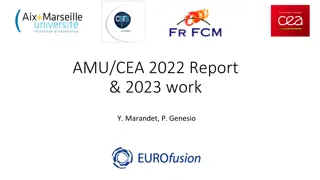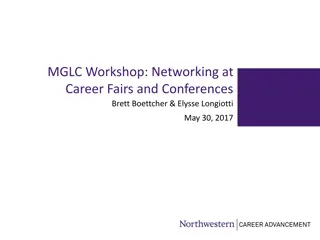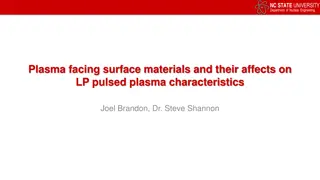Advancing Plasma Medicine: Research Contributions and Networking Opportunities
Explore the latest in plasma medicine research at the II Annual Meeting. Share your results, network with peers, and contribute to the field through collaborative discussions. Answer key questions, meet deliverables, and pave the way for advancements in plasma therapies and biomedical applications.
Download Presentation

Please find below an Image/Link to download the presentation.
The content on the website is provided AS IS for your information and personal use only. It may not be sold, licensed, or shared on other websites without obtaining consent from the author.If you encounter any issues during the download, it is possible that the publisher has removed the file from their server.
You are allowed to download the files provided on this website for personal or commercial use, subject to the condition that they are used lawfully. All files are the property of their respective owners.
The content on the website is provided AS IS for your information and personal use only. It may not be sold, licensed, or shared on other websites without obtaining consent from the author.
E N D
Presentation Transcript
WGX: TITLE OF YOUR PRESENTATION WGX: TITLE OF YOUR PRESENTATION Name Surname, Institute/University, Country
Duration of your presentation: SHORT: 3 min The length of your talk was indicated in the acceptance email. In case of doubt, you may check the program on slide 8, where the codes before your surname indicate the length: L accounts for LONG and S for short. WG#-L# Surname WG#-S# Surname Presentations must be UPLOADED before the 2ndSeptember (see slide 6 for link to upload and further instructions) There will be not space for Q&A, but we will have time for discussions and networking during coffee breaks, WG discussions and free time.
Dont forget: Keep in mind that the II annual meeting differs from a conference as its primary focus is on information sharing. Thus, we would like to ask you to: Present your results in the context of your WG Indicate how your research contributes to the advancement of your WG and the field of plasma medicine This will contribute to: Producing deliverables for the action (see slide 5). Foster networking opportunities, emphasize potential collaborations and provide details about the processes and resources you are willing to share.
Few examples of questions to be answered Could your protocol support writing a common procedure to compare results among different groups? Have you found specific interactions/pathways/ biological effect/mechanisms, etc... induced by plasma treatments? Do you have any input on therapeutical effect/ safety in the clinical use of plasma? Please refer to the list of deliverables on the next page
Deliverables Month Description of the deliverable Review of the existing bioactive physical and chemical components from CAP/PTL. Description of the currently known molecular interactions between CAP/PTL and eukaryotic cells or procariotes, prions, virus Definition of standard protocols measuring physical and chemical characteristics of CAP and PTL and its induced effect in-vivo treatment of biological samples Report identifying the fundamental and critical points that require more investigation to boost CAP- and PTL-based therapies and biomedical applications. Development of standard protocols and guidelines to characterize and test CAP and PTL for antimicrobial and antiviral purposes. Report on the evaluation of standard decontamination protocols on relevant biomaterials, & potential translation of results to industrial scale. Report on the evaluation of standard decontamination protocols onto pathogenic bioaerosols, and the potential translation of experimental results to industrial scale. Development of standard techniques and protocols to characterize and test CAP and PTL for skin treatment applications. Report on the mechanism of action, therapeutic effect &safety of CAP and PTL therapies for tissue regeneration & decontamination in wound healing. WG4 D10 Development of standard techniques and protocols to characterize and test CAP and PTL as cytotoxic agent in anticancer therapies. D11 Report on the mechanism of action and cytotoxic effect of CAP and PTL on cancer cells. D12 Identify and describe the common therapeutic and side effects to determine the safety of CAP and PTL-based anticancer therapies. WG5 D13 Report on the effectiveness and safety of CAP and PTL-based therapies combined with biomaterials for skin regeneration. D14 Report on the effectiveness and safety of anticancer co-treatments combining CAP and PTL with low doses of chemotherapeutic drugs or specific metabolic inhibitors. D15 Report on the potential use of CAP and PTL combined with biomaterials in the regenerative medicine field. WG1 D1 18 24 24 D2 D3 D4 30 WG2 D5 24 36 D6 D7 48 WG3 D8 36 48 D9 30 48 48 36 48 48
UPLOAD INSTRUCTIONS Dear attendees, The LOC kindly requests that you submit your presentation in the designated UPLOAD FOLDER according to your scheduled time slot (see programme on slide 8). Please, provide the presentation before 2nd September, since the merge of all the presentations will be quite time consuming. Thank you for your cooperation, and we look forward to your valuable contributions to the 2ndAnnual Meeting. UPLOAD FOLDERS Please rename your presentation according to the program nomenclature Mon, September 4 session: Folder 1 WG#-L# Surname.pptx Tue, September 5 morning session: Folder 2 WG#-S# Surname.pptx Tue, September 5 afternoon session: Folder 3 WG#-STSM# Surname.pptx Wed, September 6 session: Folder 4 Thu, September 7 session: Folder 5
TIMING AND UPLOAD Using personal laptops in the Engineering Faculty is not permitted. Therefore, we request all presenters to upload (slide 5 upload instructions) their presentations limited to the .ppt format, as no other file types will be accepted. This step is essential for the Local Organizing Committee (LOC) to merge all the presentations seamlessly. Considering the large number of participants, our agenda is tightly packed. It is crucial to adhere to the schedule without any delays. To ensure efficiency, session chairs and the LOC will kindly request presenters to conclude their presentations within the scheduled time, to transition to the the next presenter smoothly. Your cooperation in adhering to the schedule is highly appreciated, as it will contribute to the event s overall success.
